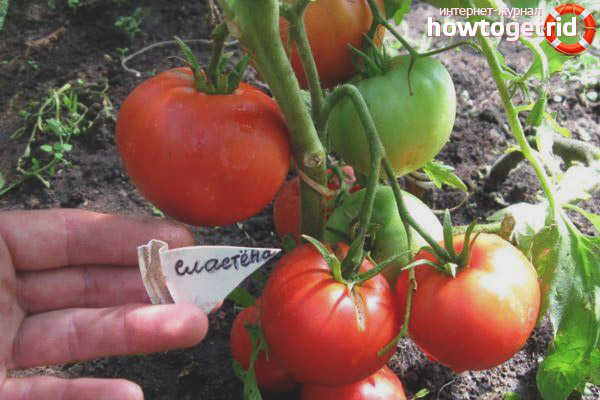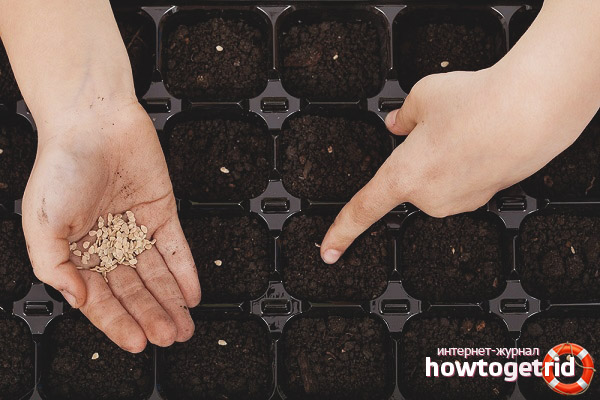The content of the article
Variety Slastena was developed in 2000 in Russia. In the southern regions it is planted in open ground, and in the Urals, the Far East, and also in Siberia, in greenhouses. This type of tomato belongs to the early ones. From planting seedlings in the soil to harvesting it takes about 3 months.
general characteristics
Bushes sweetened with indeterminate, standard. If you grow them on beds, they grow up to 100 cm in height. In greenhouses, they are slightly higher - up to 130 cm. They are distinguished by their rare leafy appearance, the leaves are small, have a dark green hue. Above the 9th sheet, the first brush is formed, and the rest - after 3 sheets. At the same time, on the hand grows to about 40 fruits.
Tomatoes have a slightly elongated cylindrical shape. Ripe fruits have a burgundy hue, sometimes scarlet. The skin is quite dense. The taste is sweet, the finish is honey. The fruits are small. Their weight is approximately 35-50 g. They have 4 seed chambers.
Tomatoes of this variety have good fresh taste. But well suited for canning. But not suitable for pickling in a barrel.
Advantages and disadvantages
The variety has the following advantages:
- Tomatoes are small and sweet.
- The peel does not crack.
- Ovary occurs almost simultaneously.
- Plants are not afraid of temperature changes.
- They ripen quickly and tolerate transportation well.
- Productivity is good. From one plant usually collect up to 2.5 kg.
- Develop normally even in depleted soil.
- It can be stored for a long time.
- They rarely suffer from brown spotting, late blight. Resistant to root rot.
- Great for canning.
The disadvantages are that the bushes need to remove stepsons and tying.
Sowing
- Sowing should occur in the last days of March. Seeds purchased on the market must be treated with a disinfectant. They are poured into a bag of gauze, and then dipped in a pre-prepared solution of manganese for about 20 minutes. To prepare the solution, you need to dissolve 1 g of the product in 125 ml of water. After 20 minutes, be sure to remove the seeds from the solution so as not to impair their germination, and rinse.
- Next, you need to prepare the substrate. For this, turf, peat and humus are taken. For each bucket of substrate it is recommended to add superphosphate and urea - 1 tsp. each means.
- To disinfect the soil, pour it with a solution of manganese. After this, you need to keep the substrate moist for about 10 days so that beneficial bacteria develop again.
- Sow the seeds into the substrate, dipping them about 1 cm. Lightly water using a spray gun. We cover with a film, put the container in a warm place. It is necessary to maintain a temperature of 26-29 degrees.
Seedlings
When the shoots hatch, it is necessary to remove the film. We put the box on the window. When 2 leaves appear, we plant the plants in peat cups. The next morning should be irrigated. For 15 days after planting, they harden the plants, taking them out daily for a while to the street.
Disembarkation
- The land should be prepared since the fall, scattering about 3.5 kg of manure per square meter of land, the soil is dug up. In the spring, the same amount of manure is scattered, but rotted.
- Potassium chloride is scattered on the same area - st. l., superphosphate - 4 tbsp. l Dig the ground again.
- The diameter of the holes should be about 15 cm, and the depth - 28-31 cm. Seedlings are planted in a checkerboard pattern. Immediately you need to drive in pegs and tie up the plants.
Care
- After planting, after a week - apply top dressing. Manure is bred in a bucket - about 1 kg.When it is infused - watered under the root.
- Fertilizers are applied during irrigation, and after that, the earth is necessarily loosened. After fertilizing for the first time, mulch the beds using straw or pine needles.
- Not only the trunk should be tied, but also the hands. In the greenhouse, it is recommended to form 2 stems, and in the beds - at 3. Three steps a month to remove stepsons.
Pests and diseases
- Prevent by ventilating the greenhouse daily. This variety, although resistant to temperature changes, it is still advisable to ensure that it is maintained at a normal level.
- Tomatoes often infect slugs. Therefore, it is necessary to eliminate weeds on time. On the soil, you can pour a little lime, sand or nutshells in crushed form.
- To protect plants from aphids, the drug Bison should be used. An effective remedy such as Confidor will help against whiteflies.
Those who grow tomatoes of this variety, note its indisputable advantages. Tomatoes are small and sweet, they are loved by children.
Video: Slastena Tomatoes












Submit